I got into an argument with a friend over what constitutes a “part” of something. She claims that a pre-born baby is part of its mother, and she referred to it as a parasite. I vehemently disagreed, pointing out that if the child is a parasite (which it is) then it most certainly is not part of the mother, and furthermore, it can be nothing other than a human person.
The reason for this is that what defines a human, constitutionally, is the presence of human DNA in our cells. The human constitution has nothing to do with our abilities to reason, dance, or divide. Any “part” of a human (like the head, foot, or duodenum) has the same constitution as the whole (much like all the US states are under the same Constitution of 1787). Things like our clothes, the food in various stages of digestion inside of us, or an unborn baby inside its mother’s womb do not share the same genetic constitution. They have their own constitutions. In fact, that unborn baby is just as substantially human as it’s mother, and it is unique—a feature of each human.
The inability of most scientists to grasp this obvious fact is astounding. So astounding that I think it’s rather a case of the scientists not wanting to believe due to preconceptions (or paradigigms), a phenomenon that has plagued science from the beginning.
29 December 2006
Gender Tester
This is a neat gender testing algorithm developed by one of the computer science professors at my university, the Illinois Institute of Technology.
My scores will disclosed in my next post.
My scores will disclosed in my next post.
27 December 2006
Nature's Oddities Part 3: Giant Tubeworms
Another oddball from the deep! Even deeper than the hagfish (over 5000 feet), in the thermal vents on the bottom of the pacific ocean, lies large colonies of the Giant (up to 8 feet long) Tubeworm, or Rifita. Pachyptila.
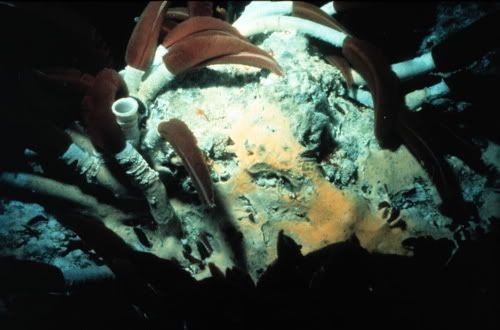
Discovered in 1977 by the unmanned deep sea exploration vessel Alvin (not from Alvin and the Chipmunk’s fame), giant tubeworms prefer to live near “black smokers,” a type of hydrothermal vent on the ocean floor characterized by superheated water rich in dissolved minerals (mostly sulfides) which crystallize to create the black plume that gives “black smokers” their name.

Giant tubeworms exploit lithotrophic bacteria to nourish themselves. Almost all organisms on earth are phototrophic (derive energy from light: plants) or autotrophic (derive energy from organic materials: animals, fungi). Lithotrophic organisms derive their energy directly from inorganic chemical reactions such as the oxidation of hydrogen sulfide (the gas that gives rotten eggs their odor). The bacteria make food for themselves using the energy from these reactions and can synthesize all the amino acids, carbohydrates, lipids, and other important bio-molecules they need just from hydrogen sulfide, carbon dioxide, oxygen and trace amounts of certain minerals.
The juvenile tubeworm has a primitive mouth and gut and ingests these bacteria, but does not digest them. As it grows and accumulates enough of these symbiotic bacteria, its mouth and gut are lost, making the adult tubeworm the only creature (that I know of at least) where the adult is less morphologically sophisticated than the juvenile. The bacteria take some of the food for themselves, but most of it is passed off to the enormous tubeworms for nourishment.
The tubeworm’s adult body is a veritable Garden of Eden for these bacterial. It’s highly vascularized “plume” near the top of the tubeworm and features the worlds most remarkable hemoglobins in order to capture oxygen (like crack cocaine for these bacteria) that is very difficult in an environment so enriched in sulfur.
The hemoglouins are enormous! Sometimes a hundred globins long (mammals have 2 pair of globins in our hemoglobin), and it is truly a biochemical marvel.
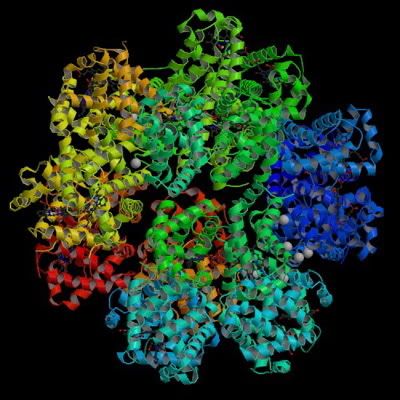
The environment these tubeworms call home would simultaneously boil (752 degrees F), crush (2000 PSI), and poison a human or just about any other creature. The tubeworm’s ability to not only endure, but thrive, in these conditions is incredible. How their tissues can withstand such extreme makes one re-think the capabilities of living things. The first high-strength metal vessels that went to these depths were easily crushed, and none could have hoped to endure the extreme temperatures. Alvin was the first to manage, and it was not developed until the 1965. Russians had been launching people into space by this time. We were only four years away from landing on the moon, but we were just starting to explore the depths of our own rock orbiting the sun!

Discovered in 1977 by the unmanned deep sea exploration vessel Alvin (not from Alvin and the Chipmunk’s fame), giant tubeworms prefer to live near “black smokers,” a type of hydrothermal vent on the ocean floor characterized by superheated water rich in dissolved minerals (mostly sulfides) which crystallize to create the black plume that gives “black smokers” their name.

Giant tubeworms exploit lithotrophic bacteria to nourish themselves. Almost all organisms on earth are phototrophic (derive energy from light: plants) or autotrophic (derive energy from organic materials: animals, fungi). Lithotrophic organisms derive their energy directly from inorganic chemical reactions such as the oxidation of hydrogen sulfide (the gas that gives rotten eggs their odor). The bacteria make food for themselves using the energy from these reactions and can synthesize all the amino acids, carbohydrates, lipids, and other important bio-molecules they need just from hydrogen sulfide, carbon dioxide, oxygen and trace amounts of certain minerals.
The juvenile tubeworm has a primitive mouth and gut and ingests these bacteria, but does not digest them. As it grows and accumulates enough of these symbiotic bacteria, its mouth and gut are lost, making the adult tubeworm the only creature (that I know of at least) where the adult is less morphologically sophisticated than the juvenile. The bacteria take some of the food for themselves, but most of it is passed off to the enormous tubeworms for nourishment.
The tubeworm’s adult body is a veritable Garden of Eden for these bacterial. It’s highly vascularized “plume” near the top of the tubeworm and features the worlds most remarkable hemoglobins in order to capture oxygen (like crack cocaine for these bacteria) that is very difficult in an environment so enriched in sulfur.
The hemoglouins are enormous! Sometimes a hundred globins long (mammals have 2 pair of globins in our hemoglobin), and it is truly a biochemical marvel.

The environment these tubeworms call home would simultaneously boil (752 degrees F), crush (2000 PSI), and poison a human or just about any other creature. The tubeworm’s ability to not only endure, but thrive, in these conditions is incredible. How their tissues can withstand such extreme makes one re-think the capabilities of living things. The first high-strength metal vessels that went to these depths were easily crushed, and none could have hoped to endure the extreme temperatures. Alvin was the first to manage, and it was not developed until the 1965. Russians had been launching people into space by this time. We were only four years away from landing on the moon, but we were just starting to explore the depths of our own rock orbiting the sun!
25 December 2006
Nature's Oddities Part 2: The Hagfish
"Truth must necessarily be stranger than fiction; for fiction is the creation of the human mind and therefore congenial to it."--G. K. Chesterton.
This quote is what inspired my Nature's Oddities series, and the hagfish could not be a better example of Chesterton’s paradox!
The hagfish belongs to the class Myxini, a Latin name that comes from the Greek work myxa, meaning mucus. I also think Myxini would be an excellent name for a Korean-built compact car. Move over Tiburon (shark in Spanish), the Myxini is coming to town!
The hagfish is very primitive, largley unchanged for perhaps 300 million year, but it has a scant fossil record. The first fossil was discovered in Northeastern Illinois (which is a rich palentological area. Braidwood, IL, near the powerplant's cooling lake, is an excellent spleunking place).
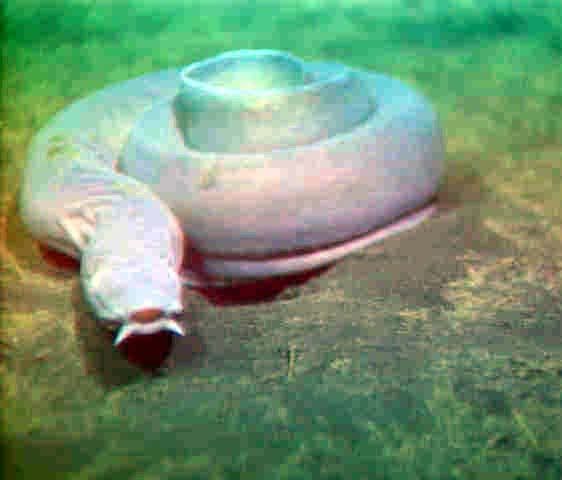
The oddness of the hagfish is tremendous, and it has definitely earned its place in my canon of oddball creatures. The hagfish is a vermiform (worm-like) creature found mainly in the Pacific Ocean (both the American and Asian sides), but it is also found in the Atlantic and in Scandinavian fjords. It’s a jawless vertebrate, like its more advanced cousin the lamprey. The hagfish has only a rudimentary skull and no actual vertebra. Unlike other creatures, its mouth horizontally articulates. It lives at depths of up to 4000 feet. It’s hermaphrodic, with both male and female gametes and genitalia, but it’s doubtful that they can self-fertilize (nobody has taken much interest in their reproductive idiosyncrasies, unfortunately). Hagfish are practically blind, and they can coil their body in overhand knots—an ability no snake, eel, lizard has. This ability comes in handy when it wants squirm free of its suffocatingingly think mucus, which it uses for predation, defense, and to keep its skin (which is used to make purses in Korea) healthy.
The hagfish has perhaps the most unusual way to subdue prey. Its extremely slow metabolism allows it to rest, motionless, for months on the ocean bottoms in silt and sand. Usually, only its head, which has a small olfactory opening, mouth, and respiratory opening, is exposed to the seawater. When it senses (by smell and vibration) a suitable victim, it swims into the passing fish though the mouth or gill opening and rapidly secrets its special mucus, which soon suffocates even large, predatory fish. It then eats its victim from the inside out, using its body as temporary shelter. It also feeds upon small annelid worms that live on the ocean floor and dead fish, as well.
Sounds like something out of a space alien movie, but it is indeed real.
Serious (as opposed to whimsical) scientists find the hagfish interesting because it has perhaps the most efficient and remarkable mucus of any creature. Mucus may not interest the average person much, but mucus is indeed important. Without it, any mammal would die from suffocation (it allows for gaseous exchange in the lung; insufficient pulmonary mucus is the primary cause of premature baby mortality). In the ocean, it is critical for keeping the right amount of the right salts inside the fish instead of diffusing into the water. The hagfish, however, has made its living off its mucus, so it is not surprising at all that it is really good at what it does. It is the professional mucus maker! Slimer is a hack by comparison.

Hagfish mucus is made of tiny protein fibrils very similar in structure to collagen (the protein that makes up most connective tissues in the human body, and about 27% of total protein by weight in adults). This alone makes it special, because most mucus is entirely made of mucin, the characteristic carbohydrate of mucus, water, a few salts, and anti-bacterial enzymes.
Another remarkable feature is that hagfish mucus 99.996% seawater, 0.0015% mucin and 0.002% threads. It is approximately 1000x more dilute than mammalian mucus. This is how the hagfish is able to make so much mucus so fast and with so little metabolic effort.
When the fibrils are released from the organism, mucin droplets deposit on them and form cross-links between the fibrils adding strength. Hagfish mucus is also one of the few muci (what the plural of mucus?) that functions in a wide range of temperatures (most muci functions best at body temperature of the organism). The strength, potency, and versatility of hagfish mucus have made it interesting to military and medical researchers. It is an example of the coveted, “space filling gel” which could be used to stop bleeding from massive wounds. Mucus also usually has anti-bacterial function, making it even more useful in this regard. I think it would be much better to develop some sort of weapon that would project slime on an enemy, immobilizing them. I am sure DARPA would abrubtly reject my proposal, but I can dream.
Bardack, D. (1991) First fossil hagfish (Myxinoidea): a record from the Pennsylvanian of Illinois. Science 254:701-703.
Gosline, J. M. et. al. (2005) Composition, morphology and mechanics of hagfish slime. Journal of Experimental Biology 208, 4613-4625
This quote is what inspired my Nature's Oddities series, and the hagfish could not be a better example of Chesterton’s paradox!
The hagfish belongs to the class Myxini, a Latin name that comes from the Greek work myxa, meaning mucus. I also think Myxini would be an excellent name for a Korean-built compact car. Move over Tiburon (shark in Spanish), the Myxini is coming to town!
The hagfish is very primitive, largley unchanged for perhaps 300 million year, but it has a scant fossil record. The first fossil was discovered in Northeastern Illinois (which is a rich palentological area. Braidwood, IL, near the powerplant's cooling lake, is an excellent spleunking place).

The oddness of the hagfish is tremendous, and it has definitely earned its place in my canon of oddball creatures. The hagfish is a vermiform (worm-like) creature found mainly in the Pacific Ocean (both the American and Asian sides), but it is also found in the Atlantic and in Scandinavian fjords. It’s a jawless vertebrate, like its more advanced cousin the lamprey. The hagfish has only a rudimentary skull and no actual vertebra. Unlike other creatures, its mouth horizontally articulates. It lives at depths of up to 4000 feet. It’s hermaphrodic, with both male and female gametes and genitalia, but it’s doubtful that they can self-fertilize (nobody has taken much interest in their reproductive idiosyncrasies, unfortunately). Hagfish are practically blind, and they can coil their body in overhand knots—an ability no snake, eel, lizard has. This ability comes in handy when it wants squirm free of its suffocatingingly think mucus, which it uses for predation, defense, and to keep its skin (which is used to make purses in Korea) healthy.
The hagfish has perhaps the most unusual way to subdue prey. Its extremely slow metabolism allows it to rest, motionless, for months on the ocean bottoms in silt and sand. Usually, only its head, which has a small olfactory opening, mouth, and respiratory opening, is exposed to the seawater. When it senses (by smell and vibration) a suitable victim, it swims into the passing fish though the mouth or gill opening and rapidly secrets its special mucus, which soon suffocates even large, predatory fish. It then eats its victim from the inside out, using its body as temporary shelter. It also feeds upon small annelid worms that live on the ocean floor and dead fish, as well.
Sounds like something out of a space alien movie, but it is indeed real.
Serious (as opposed to whimsical) scientists find the hagfish interesting because it has perhaps the most efficient and remarkable mucus of any creature. Mucus may not interest the average person much, but mucus is indeed important. Without it, any mammal would die from suffocation (it allows for gaseous exchange in the lung; insufficient pulmonary mucus is the primary cause of premature baby mortality). In the ocean, it is critical for keeping the right amount of the right salts inside the fish instead of diffusing into the water. The hagfish, however, has made its living off its mucus, so it is not surprising at all that it is really good at what it does. It is the professional mucus maker! Slimer is a hack by comparison.

Hagfish mucus is made of tiny protein fibrils very similar in structure to collagen (the protein that makes up most connective tissues in the human body, and about 27% of total protein by weight in adults). This alone makes it special, because most mucus is entirely made of mucin, the characteristic carbohydrate of mucus, water, a few salts, and anti-bacterial enzymes.
Another remarkable feature is that hagfish mucus 99.996% seawater, 0.0015% mucin and 0.002% threads. It is approximately 1000x more dilute than mammalian mucus. This is how the hagfish is able to make so much mucus so fast and with so little metabolic effort.
When the fibrils are released from the organism, mucin droplets deposit on them and form cross-links between the fibrils adding strength. Hagfish mucus is also one of the few muci (what the plural of mucus?) that functions in a wide range of temperatures (most muci functions best at body temperature of the organism). The strength, potency, and versatility of hagfish mucus have made it interesting to military and medical researchers. It is an example of the coveted, “space filling gel” which could be used to stop bleeding from massive wounds. Mucus also usually has anti-bacterial function, making it even more useful in this regard. I think it would be much better to develop some sort of weapon that would project slime on an enemy, immobilizing them. I am sure DARPA would abrubtly reject my proposal, but I can dream.
Bardack, D. (1991) First fossil hagfish (Myxinoidea): a record from the Pennsylvanian of Illinois. Science 254:701-703.
Gosline, J. M. et. al. (2005) Composition, morphology and mechanics of hagfish slime. Journal of Experimental Biology 208, 4613-4625
24 December 2006
Lazy Bum Catholics
I am postponing the 2nd installment of Nature’s oddities, the Hagfish, to discuss a very pervasive scandal in the Church.
Cafeteria Catholicism. I normally do not like using pop-Cath phrases like “cafeteria,” but I think it is a good phrase for describing the situation.
Today Deacon Juncer discussed how people were petitioning Cardinal George to commute the Nativity of our Lord to Sunday or somehow invent some way to commute their Sunday obligation to tomorrow. See, last year Christmas fell on a Sunday, so both the Sunday obligation and the Holy Day of the Nativity of our Lord (Christmas) were fulfilled by the same mass. I guess in one short year people became so lazy that they could not bear to go to Mass this morning and tonight or they could not tolerate going to Mass this morning and tomorrow morning. I could tell that MANY people are eschewing today’s mass, since the population of laypeople at St. John Cantius today was very low. This is so disappointing!
If you are a materialist, it is obviously a good deal to go to Church at least. Church is enjoyable, especially if you like music, pageantry, costumes, candles, incense, paintings, socializing. At St. John’s they have a Café that is very reasonably priced ($1 dollar for an enormous cheese Danish that would cost around $3-4 at Starbucks). They don’t even charge admission at Church! It takes one hour. It’s on your day off. Mass is offered at a variety of convenient times. There is ample free parking!
I’ve paid money ($6-9 often) to see nauseating movies like Moulin Rouge. Going to Church is a much better deal by any comparison.
This is why I feel little remorse for those souls that do not go to Church on Sunday or ask ridiculous things of our Cardinal. Why do they even ask? They obviously are going to do whatever they want. By asking they are assuring the sinfulness of their action. At least if they didn’t ask, they could claim ignorance, which unlike in civil law, counts for something.
I’ve heard many honest and genuine Catholics lament these problems, and pass the blame to poor catechesis, I believe this is quite erroneous. I have found many “lazy bum” or “fallen away” type Catholics to have very good knowledge and understanding of the Church, Her teachings, etc. Many even have understandings of philosophy and theology that far surpass my own. Furthermore, information is more available today than it ever has been in the Church’s history. Books are more available and cheaper. The Internet is free, and that Vatican’s website, which can be accessed 24/7/365.25, has all the information you need to be a good Catholic.
I cannot see how even the poorest catechesis can fail to drive home the fact that you have to go to Mass on Sunday and Holy Days of Obligation. There are only a handful of essentials to be Catholic. You do not even need to be literate to be a good Catholic. You really only have to follow the rules (Catechism of the Catholic Church), go to Mass on Sunday and Holy Days, know a handful of simple prayers, and give what alms you can. Is this that much to ask for the benefit of eternal salvation and avoidance of eternal hellfire? Not really, but you have to believe in salvation and hellfire.
Even though it is not hard to keep up a façade of being Catholic, it does take a small bit of denial to avoid things like masturbation, fornication, contraception, etc. These are the sins I (and Our Lady of Fatima) believe send the greatest number of people down the road to perdition, especially younger people.
But even here, it’s not that hard to avoid these things. And you’re generally better off materially if you do avoid them. People say it’s hard to avoid these things, and I have had one Psychology professor claim it is impossible, to which I retorted “I am living proof that you are incorrect, Dr. so-and-so.” I cannot understand why people insist on the difficulty of avoiding these sins. But let’s just say they are hard for the sake of argument. In this case, Fear of the Lord should easily overwhelm your desire to commit these sins.
Even if you don’t believe everything the Church says. And even if you don’t believe what the Bible says. Even if you don’t believe that God destroyed entire peoples and struck down people like Onan outright, you should still have some fear. Even the most rudimentary understanding of God (which 80% of Americans claim to have) will necessitate that somehow He created the universe. Even if you don’t believe in the Holy Trinity, you must believe that God is fantastically powerful, because this is necessary to create something as vast, complex, and orderly as the universe. If you don’t then you don’t believe in God. Whatever you are believing in cannot be God. Given that you believe in this fantastically powerful being, wouldn’t it be at least somewhat prudent to be afraid of Him. I am afraid of Doberman Pincers because they are very powerful compared to most animals. I am afraid of Tractor Trailers because they weigh 30-40 tons and could easily crust my 2500 lb Corolla. I am afraid of the Anthrax, even though it a millionth of my size. Doberman Pincers, Tractor Trailers, and Bacillus Anthracis pale in comparison to the power of any being that willed into existence the entire universe!
Now, some people believe that God loves us so much that he could never do anything we wouldn’t enjoy, like sending us to Hell. First off, I want to know where this idea comes from. It is obviously an addition to the rudimentary understanding of God—the necessarily powerful being that created the universe. This idea must come from somewhere, because it is not obvious from the definition of God. If you are willing to add to an understanding of God beyond the obvious, why is He always loving rather than vengeful? This is a question worth asking. If you are to have any integrity, you must examine the source. I suspect that many people get this idea from cherry picking parts of the New Testament or Psalms. They overlook the other parts of the Bible where God is vengeful and destructive. They may be Unitarians or adhere to some other type of therapeutic belief system. In any case, it is simple self-delusion.
Cafeteria Catholicism. I normally do not like using pop-Cath phrases like “cafeteria,” but I think it is a good phrase for describing the situation.
Today Deacon Juncer discussed how people were petitioning Cardinal George to commute the Nativity of our Lord to Sunday or somehow invent some way to commute their Sunday obligation to tomorrow. See, last year Christmas fell on a Sunday, so both the Sunday obligation and the Holy Day of the Nativity of our Lord (Christmas) were fulfilled by the same mass. I guess in one short year people became so lazy that they could not bear to go to Mass this morning and tonight or they could not tolerate going to Mass this morning and tomorrow morning. I could tell that MANY people are eschewing today’s mass, since the population of laypeople at St. John Cantius today was very low. This is so disappointing!
If you are a materialist, it is obviously a good deal to go to Church at least. Church is enjoyable, especially if you like music, pageantry, costumes, candles, incense, paintings, socializing. At St. John’s they have a Café that is very reasonably priced ($1 dollar for an enormous cheese Danish that would cost around $3-4 at Starbucks). They don’t even charge admission at Church! It takes one hour. It’s on your day off. Mass is offered at a variety of convenient times. There is ample free parking!
I’ve paid money ($6-9 often) to see nauseating movies like Moulin Rouge. Going to Church is a much better deal by any comparison.
This is why I feel little remorse for those souls that do not go to Church on Sunday or ask ridiculous things of our Cardinal. Why do they even ask? They obviously are going to do whatever they want. By asking they are assuring the sinfulness of their action. At least if they didn’t ask, they could claim ignorance, which unlike in civil law, counts for something.
I’ve heard many honest and genuine Catholics lament these problems, and pass the blame to poor catechesis, I believe this is quite erroneous. I have found many “lazy bum” or “fallen away” type Catholics to have very good knowledge and understanding of the Church, Her teachings, etc. Many even have understandings of philosophy and theology that far surpass my own. Furthermore, information is more available today than it ever has been in the Church’s history. Books are more available and cheaper. The Internet is free, and that Vatican’s website, which can be accessed 24/7/365.25, has all the information you need to be a good Catholic.
I cannot see how even the poorest catechesis can fail to drive home the fact that you have to go to Mass on Sunday and Holy Days of Obligation. There are only a handful of essentials to be Catholic. You do not even need to be literate to be a good Catholic. You really only have to follow the rules (Catechism of the Catholic Church), go to Mass on Sunday and Holy Days, know a handful of simple prayers, and give what alms you can. Is this that much to ask for the benefit of eternal salvation and avoidance of eternal hellfire? Not really, but you have to believe in salvation and hellfire.
Even though it is not hard to keep up a façade of being Catholic, it does take a small bit of denial to avoid things like masturbation, fornication, contraception, etc. These are the sins I (and Our Lady of Fatima) believe send the greatest number of people down the road to perdition, especially younger people.
But even here, it’s not that hard to avoid these things. And you’re generally better off materially if you do avoid them. People say it’s hard to avoid these things, and I have had one Psychology professor claim it is impossible, to which I retorted “I am living proof that you are incorrect, Dr. so-and-so.” I cannot understand why people insist on the difficulty of avoiding these sins. But let’s just say they are hard for the sake of argument. In this case, Fear of the Lord should easily overwhelm your desire to commit these sins.
Even if you don’t believe everything the Church says. And even if you don’t believe what the Bible says. Even if you don’t believe that God destroyed entire peoples and struck down people like Onan outright, you should still have some fear. Even the most rudimentary understanding of God (which 80% of Americans claim to have) will necessitate that somehow He created the universe. Even if you don’t believe in the Holy Trinity, you must believe that God is fantastically powerful, because this is necessary to create something as vast, complex, and orderly as the universe. If you don’t then you don’t believe in God. Whatever you are believing in cannot be God. Given that you believe in this fantastically powerful being, wouldn’t it be at least somewhat prudent to be afraid of Him. I am afraid of Doberman Pincers because they are very powerful compared to most animals. I am afraid of Tractor Trailers because they weigh 30-40 tons and could easily crust my 2500 lb Corolla. I am afraid of the Anthrax, even though it a millionth of my size. Doberman Pincers, Tractor Trailers, and Bacillus Anthracis pale in comparison to the power of any being that willed into existence the entire universe!
Now, some people believe that God loves us so much that he could never do anything we wouldn’t enjoy, like sending us to Hell. First off, I want to know where this idea comes from. It is obviously an addition to the rudimentary understanding of God—the necessarily powerful being that created the universe. This idea must come from somewhere, because it is not obvious from the definition of God. If you are willing to add to an understanding of God beyond the obvious, why is He always loving rather than vengeful? This is a question worth asking. If you are to have any integrity, you must examine the source. I suspect that many people get this idea from cherry picking parts of the New Testament or Psalms. They overlook the other parts of the Bible where God is vengeful and destructive. They may be Unitarians or adhere to some other type of therapeutic belief system. In any case, it is simple self-delusion.
23 December 2006
Nature’s Oddities Part 1: The Lamprey
I am opening a new series on odd creatures. Today we will begin with my favorite oddball creature, the lamprey.
Lampreys have an eel-like appearance (but they are not eels!) and a cartilaginous skeleton (like sharks and rays). They have a single olfactory nostril, which is possibly the most sensitive “nose” of all animals. They have strangely shaped circular gills, usually 5 or 7 of them on each side. The most primitive vertebrate, the hagfish (covered tomorrow), does not have a true spine and only very primitive “vertebra”—the bones protecting the spinal nerve. The lamprey is a bit more developed, but still quite unlike all other vertebrates which have fully developed spinal columns, vertebra, and jaws. So in the entire subphyla vertebrata two very primitive groups exist (“jawless” hagfish and lampreys) and many other advanced groups exist (“jawed” mammals, birds, reptiles, and ray-finned fish [the dominant group]).

Here is nice picture of the business end of the lamprey--it’s jawless rasp-like sucker mouth. I am glad I am not a trout!

As you can guess, lampreys are parasitic in their adult life stage. They cling on to a fish and suck their blood, usually killing their host and moving on to a few more before settling down and making babies. I have heard that a single lamprey (which weights only a few ounces) can kill 25 lbs of fish, which makes them quite destructive to fish populations. Interestingly, some fish have a reflexive jerk when you poke them on their lower flanking quarters (the area lampreys usually attack). This is of course to avoid getting stuck by a lamprey. The reflex uses the same type neuronal pathway that humans use when doctors bump our knees. I suggest trying it yourself next time you catch a fish.
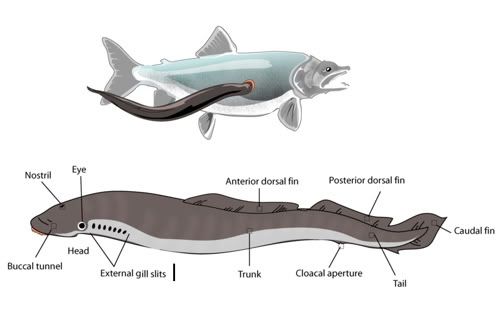
Lampreys (and hagfish, probably) have a primordial immune system rather unlike our own. Humans (and almost all other vertebrates) have immune systems that operate using anti-bodies, small molecules secreted by B-lymphocytes that attach to pathogens and other foreign substances in the body. The antibodies cause the pathogens to clump together and flag them for destruction by cytotoxic T cells and phagocytic (cell-eating) cells, like macrophages. Some antibodies damage the pathogens themselves. This is all part of what is known as the “adaptive immune response” since it is an adaptive process. Antibodies are tailored to the pathogen at hand. This is different from the activity of natural killer T cells, which attack any cell without characteristic features (such as MHC receptors) of the organism’s own cells. Natural killer cells do not need antibodies to be raised in order to attack. Lampreys are different in that they have an adaptive immune response with no antibodies.
Antibodies are the hingepin of the entire immune response. This is due to their “hyper variable” region. Antibodies’ hyper variable regions can be adapted to almost any pathogens’ unique surface receptor proteins (called antigens). There are millions of different pathogens that are constantly adapting to avoid selection by antibodies, consequently, antibodies are constantly adapting as well. What allows for the enormous flexibility of the antibody is the many ways genes can recombine to produce different immunologlobin domains (areas of activity) in the hyper variable regions of he antibody. It was long thought that nature had a very limited capacity of arranging these genes in order to achieve this variable nature. The mechanism used was though to be the only one. This was found to be incorrect when the lamprey’s immune system was examined.
Lampreys use an entirely different molecule called a VLR (variable lymphocyte receptor) to do the work of anti-bodies. And this VLR is produced in a completely different way genetically. Where all jawed vertebrates have their antibody genes regulate by the RAG genes from two different sources to generate diversity, lampreys have a very simple “cassette” of VLR genes that are clipped at different regions to produce variability. This may not seem like it is that different. But it is. Let me make an analogy. To make a cake, one baker takes some cake mix and some milk and eggs and combines them in variable amounts to produce different tasting cakes. Another baker chooses to take the cake mix with all the ingredients already combined and remove the unwanted ingredients to make different tasting cakes. It is clear now that the person who combines different ingredients has greater ability to alter the contents of the cake, since he chooses what ingredients to add. This is why the antibody method has been dominant in the world, though the simpler Lamprey system is quiet effective. It is also important to note that there is no clear way for the jawed system to develop from the jawless system. They are completely different mechanisms, but with similar functions. Sort of like the old Macs and PCs before they started doing commercials together.
Lampreys are also an exotic species to the Great Lakes. When the St. Lawrence Seaway was opened, lampreys began to swim down it from the Atlantic (like many primitive fish, lampreys can live in salt and fresh water). They started to spawn (and a single female can produce 10,000-20,000 eggs every year) and were very successful, greatly reducing the fish yields. Since then, war has raged against the Lamprey.
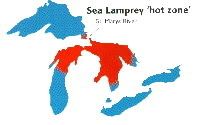
Traditionally we have used pesticides to reduce their numbers. Since Lampreys metamophisize (the only fish that do this!) like many insects (think of butterflies), many of the chemicals that interfere with metamorphosis work in both lampreys and insects. So we already had a well-developed arsenal against them. The problem is that when we dump pesticides into a lake (as opposed to spreading them on a field) the pesticides go where we don’t want them too, killing all sorts of aquatic insects that are crucial to the food chain. We tried to find other chemicals, called lampracides, that target the lamprey more specifically, but after billions of dollars of research between the US and Canadian investigators, we have been rather unsuccessful.
Currently we believe we are beating them by messing up their courtship process. I saw a presentation by the leading researcher in lampreys last year, and he developed a pheromone that was specific to the lamprey that would make the female lampreys try to mate in the wrong places and the wrong way. Lampreys need to line up in an “embrace” before mating in order for the sperm (which is ejected from the male’s body) can be captured by the female’s genitals instead of floating downstream. The male excretes a chemical (called a pheromone) to lead the female to the right position, since adult lampreys are nearly blind. When we mess with this pheromone, we confuse the girls and they don’t get any sperm. Good for us!

We invented “the pill” for the Lamprey. The one problem is that a few do get pregnant. Either the males have an extraordinary abundance of sperm produced or the females are quite fertile. It is also possible that they may still be able to do their dance without the pheromone. In any case, we are selecting for the lampreys that can evade this mechanism, and since they are so prolific, our mechanism will soon be overcome. The war continues.
I pointed out this fact to the professor, and he said that indeed this is a major problem. I think perhaps developing a VLR antagonist (sort of like an allergen to jawed vertebrates) could be developed to kill lampreys. After all, many allergens can be fatal. To my knowledge, nobody has tried this.
This is why I suggest peace as an alternative. Lampreys are considered a delicacy in France, but then again the French eat just about anything. They are enjoyed in England, Portugal, Korea, and Spain as well, which gives me hope that North Americans may learn to love lampreys. Their flesh is very rich and meat-like (because they suck blood) and it has perhaps the highest iron content of any food. For this reason lampreys were very popular for Catholics during fast times. It was like eating “meat” but not! Lamprey pie was a popular Lenten food in northern France. King Henry I was so fond of lampreys that he overate them and died (possibly from Iron poisoning or because they were rotten). I think we should keep our tax monies and start commercial fishing of Lampreys. The American public is so gullible! All that would be necessary would be celebrity endorsements of Lampreys during the super bowl. Suggestions of good celebrates to introduce the lamprey are welcome. I was thinking of Rachel Ray. Her indomitable perkiness may overcome people’s prejudice against the lamprey.
Here is a recipe I found on the internet:
Lamprey Stew with Garlic Mashed Potatoes
by Bob Bennett
Bennett's Bar and Grill, Duluth, MN
For Stew:
3 lamprey cleaned, peeled, and cut into 1/2-inch pieces
2 carrots, peeled and diced into medium size chunks
1 yellow onion, diced into medium chunks
2 stalks celery, diced into medium chunks
2 cups hearty red wine
2 cups fortified veal stock
1 bay leaf
2 tbsp. olive oil
salt and pepper to taste
Heat oil in a medium-size, heavy-gauge stock pot. Add lamprey and vegetables, then sear until vegetables are tender. Add the wine and reduce liquid by two-thirds. Add veal stock and bay leaf, reduce heat and simmer for 2 to 3 hours. Season with salt and pepper and serve on a bed of mashed potatoes as prepared below.
For potatoes:
2 lbs. red new potatoes
2 tbsp. butter
1 tbsp. minced garlic
3 tbsp. sour cream
salt and pepper to taste
Boil potatoes until soft, then drain. Place in a mixing bowl with the rest of the ingredients and mix with electric hand mixer until smooth. Keep warm until ready to serve.
Some resources:
http://en.wikipedia.org/wiki/Lamprey
http://www.hhmi.org/news/cooper.html
http://chemse.oxfordjournals.org/cgi/content/full/30/suppl_1/i307
Cooper, M. D. et. al. (2004) Somatic diversification of variable lymphocyte receptors in the agnathan sea lamprey Nature 430:174-180
(All pictures were taken from government websites [public domain] or from publicly released Wikipedia images)
Lampreys have an eel-like appearance (but they are not eels!) and a cartilaginous skeleton (like sharks and rays). They have a single olfactory nostril, which is possibly the most sensitive “nose” of all animals. They have strangely shaped circular gills, usually 5 or 7 of them on each side. The most primitive vertebrate, the hagfish (covered tomorrow), does not have a true spine and only very primitive “vertebra”—the bones protecting the spinal nerve. The lamprey is a bit more developed, but still quite unlike all other vertebrates which have fully developed spinal columns, vertebra, and jaws. So in the entire subphyla vertebrata two very primitive groups exist (“jawless” hagfish and lampreys) and many other advanced groups exist (“jawed” mammals, birds, reptiles, and ray-finned fish [the dominant group]).

Here is nice picture of the business end of the lamprey--it’s jawless rasp-like sucker mouth. I am glad I am not a trout!

As you can guess, lampreys are parasitic in their adult life stage. They cling on to a fish and suck their blood, usually killing their host and moving on to a few more before settling down and making babies. I have heard that a single lamprey (which weights only a few ounces) can kill 25 lbs of fish, which makes them quite destructive to fish populations. Interestingly, some fish have a reflexive jerk when you poke them on their lower flanking quarters (the area lampreys usually attack). This is of course to avoid getting stuck by a lamprey. The reflex uses the same type neuronal pathway that humans use when doctors bump our knees. I suggest trying it yourself next time you catch a fish.

Lampreys (and hagfish, probably) have a primordial immune system rather unlike our own. Humans (and almost all other vertebrates) have immune systems that operate using anti-bodies, small molecules secreted by B-lymphocytes that attach to pathogens and other foreign substances in the body. The antibodies cause the pathogens to clump together and flag them for destruction by cytotoxic T cells and phagocytic (cell-eating) cells, like macrophages. Some antibodies damage the pathogens themselves. This is all part of what is known as the “adaptive immune response” since it is an adaptive process. Antibodies are tailored to the pathogen at hand. This is different from the activity of natural killer T cells, which attack any cell without characteristic features (such as MHC receptors) of the organism’s own cells. Natural killer cells do not need antibodies to be raised in order to attack. Lampreys are different in that they have an adaptive immune response with no antibodies.
Antibodies are the hingepin of the entire immune response. This is due to their “hyper variable” region. Antibodies’ hyper variable regions can be adapted to almost any pathogens’ unique surface receptor proteins (called antigens). There are millions of different pathogens that are constantly adapting to avoid selection by antibodies, consequently, antibodies are constantly adapting as well. What allows for the enormous flexibility of the antibody is the many ways genes can recombine to produce different immunologlobin domains (areas of activity) in the hyper variable regions of he antibody. It was long thought that nature had a very limited capacity of arranging these genes in order to achieve this variable nature. The mechanism used was though to be the only one. This was found to be incorrect when the lamprey’s immune system was examined.
Lampreys use an entirely different molecule called a VLR (variable lymphocyte receptor) to do the work of anti-bodies. And this VLR is produced in a completely different way genetically. Where all jawed vertebrates have their antibody genes regulate by the RAG genes from two different sources to generate diversity, lampreys have a very simple “cassette” of VLR genes that are clipped at different regions to produce variability. This may not seem like it is that different. But it is. Let me make an analogy. To make a cake, one baker takes some cake mix and some milk and eggs and combines them in variable amounts to produce different tasting cakes. Another baker chooses to take the cake mix with all the ingredients already combined and remove the unwanted ingredients to make different tasting cakes. It is clear now that the person who combines different ingredients has greater ability to alter the contents of the cake, since he chooses what ingredients to add. This is why the antibody method has been dominant in the world, though the simpler Lamprey system is quiet effective. It is also important to note that there is no clear way for the jawed system to develop from the jawless system. They are completely different mechanisms, but with similar functions. Sort of like the old Macs and PCs before they started doing commercials together.
Lampreys are also an exotic species to the Great Lakes. When the St. Lawrence Seaway was opened, lampreys began to swim down it from the Atlantic (like many primitive fish, lampreys can live in salt and fresh water). They started to spawn (and a single female can produce 10,000-20,000 eggs every year) and were very successful, greatly reducing the fish yields. Since then, war has raged against the Lamprey.

Traditionally we have used pesticides to reduce their numbers. Since Lampreys metamophisize (the only fish that do this!) like many insects (think of butterflies), many of the chemicals that interfere with metamorphosis work in both lampreys and insects. So we already had a well-developed arsenal against them. The problem is that when we dump pesticides into a lake (as opposed to spreading them on a field) the pesticides go where we don’t want them too, killing all sorts of aquatic insects that are crucial to the food chain. We tried to find other chemicals, called lampracides, that target the lamprey more specifically, but after billions of dollars of research between the US and Canadian investigators, we have been rather unsuccessful.
Currently we believe we are beating them by messing up their courtship process. I saw a presentation by the leading researcher in lampreys last year, and he developed a pheromone that was specific to the lamprey that would make the female lampreys try to mate in the wrong places and the wrong way. Lampreys need to line up in an “embrace” before mating in order for the sperm (which is ejected from the male’s body) can be captured by the female’s genitals instead of floating downstream. The male excretes a chemical (called a pheromone) to lead the female to the right position, since adult lampreys are nearly blind. When we mess with this pheromone, we confuse the girls and they don’t get any sperm. Good for us!

We invented “the pill” for the Lamprey. The one problem is that a few do get pregnant. Either the males have an extraordinary abundance of sperm produced or the females are quite fertile. It is also possible that they may still be able to do their dance without the pheromone. In any case, we are selecting for the lampreys that can evade this mechanism, and since they are so prolific, our mechanism will soon be overcome. The war continues.
I pointed out this fact to the professor, and he said that indeed this is a major problem. I think perhaps developing a VLR antagonist (sort of like an allergen to jawed vertebrates) could be developed to kill lampreys. After all, many allergens can be fatal. To my knowledge, nobody has tried this.
This is why I suggest peace as an alternative. Lampreys are considered a delicacy in France, but then again the French eat just about anything. They are enjoyed in England, Portugal, Korea, and Spain as well, which gives me hope that North Americans may learn to love lampreys. Their flesh is very rich and meat-like (because they suck blood) and it has perhaps the highest iron content of any food. For this reason lampreys were very popular for Catholics during fast times. It was like eating “meat” but not! Lamprey pie was a popular Lenten food in northern France. King Henry I was so fond of lampreys that he overate them and died (possibly from Iron poisoning or because they were rotten). I think we should keep our tax monies and start commercial fishing of Lampreys. The American public is so gullible! All that would be necessary would be celebrity endorsements of Lampreys during the super bowl. Suggestions of good celebrates to introduce the lamprey are welcome. I was thinking of Rachel Ray. Her indomitable perkiness may overcome people’s prejudice against the lamprey.
Here is a recipe I found on the internet:
Lamprey Stew with Garlic Mashed Potatoes
by Bob Bennett
Bennett's Bar and Grill, Duluth, MN
For Stew:
3 lamprey cleaned, peeled, and cut into 1/2-inch pieces
2 carrots, peeled and diced into medium size chunks
1 yellow onion, diced into medium chunks
2 stalks celery, diced into medium chunks
2 cups hearty red wine
2 cups fortified veal stock
1 bay leaf
2 tbsp. olive oil
salt and pepper to taste
Heat oil in a medium-size, heavy-gauge stock pot. Add lamprey and vegetables, then sear until vegetables are tender. Add the wine and reduce liquid by two-thirds. Add veal stock and bay leaf, reduce heat and simmer for 2 to 3 hours. Season with salt and pepper and serve on a bed of mashed potatoes as prepared below.
For potatoes:
2 lbs. red new potatoes
2 tbsp. butter
1 tbsp. minced garlic
3 tbsp. sour cream
salt and pepper to taste
Boil potatoes until soft, then drain. Place in a mixing bowl with the rest of the ingredients and mix with electric hand mixer until smooth. Keep warm until ready to serve.
Some resources:
http://en.wikipedia.org/wiki/Lamprey
http://www.hhmi.org/news/cooper.html
http://chemse.oxfordjournals.org/cgi/content/full/30/suppl_1/i307
Cooper, M. D. et. al. (2004) Somatic diversification of variable lymphocyte receptors in the agnathan sea lamprey Nature 430:174-180
(All pictures were taken from government websites [public domain] or from publicly released Wikipedia images)
21 December 2006
Decorative LSD Blotter Papers
One of my friends (his blog: http://www.danielmitsui.com/hieronymus/) is an excellent artist, and he has exposed me to the wonders of icons and patterns. He has only exposed me to the religious kind, however. To my delight I came across some reproductions of decorative LSD Blotter Papers at the lab today. Its truly remarkable how much effort people put into making the papers they “drop acid” with look lovely. Perhaps they stare at them while in their trances. It is clear that different clandestine LSD manufacturers "brand" their acid with their blotter paper patterns. The most common pattern, the "Felix the Cat" pattern originates from a lab in Northern California, for example. It is assumed that LSD blotter paper branding works just like branding with other products. If you had a high you liked with the Felix the Cat brand, you are more likely to purchase it again.
Here are some examples of blotter paper patterns:



Here is the “looking glass” design, which is fairly common content for blotter papers:


Through the Looking Glass was the sequel to Lewis Carroll’s Alice’s Adventures in Wonderland. What could be a better work of literature than this for a LSD user? In Wonderland people walk backwards, see things as they have never seen before, and cat’s talk. Alice herself hallucinates when surrounded by teas, mushrooms and smoking insects. Its like an acid dream without the acid. In fact, Lewis Carroll almost certainly dabbled in psychedelic drugs, probably laudanum, a tincture of opium and (usually) alcohol. The name Mad Hatter, another reference to altered states of mind, is really a literal reference to mercury poisoning suffered by hatters in the 19th century since mercury was used to process felt at the time. Sometimes this mercury poisoning (especially when combined with alcohol consumption) leads to Korsakoff’s syndrome. This disease also made its way into art in the movie Memento based on the case study by neurologist Oliver Sacks called the "The Lost Mariner" in the book The Man Who Mistook His Wife for a Hat. What a strange world!
This is my favorite:


Yes…that is the crucified Christ on that blotter paper. And yes…that is a psychedelic insect-eyeball pattern in the background. This depiction of Jesus is very unique in that it clearly shows that He is "high." The aura of light is around his entire body, not just his head. He veins, arteries, and bones seem to be electrified. This all indicates that the artist was quite deliberate and made this drawing for this purpose.
This makes me wonder, “What would Jesus think of this?” After all, LSD is quite destructive to the mind and body, which are dwelling places of the Holy Spirit (and at times for the body and blood of Christ). In fact, at least one Priest I know has likened the tongue as a throne for Christ when we take Eucharist. How ironic that one drops acid on the tongue as well?
Alcohol is also destructive of the mind and body if taken too liberally. Is it a matter of degree? That LSD is simply too potent for reasonable use? Or it is it the fact that it is not culturally acceptable, unlike alcohol which is one of the fruits of western culture. I suppose it is both.
LSD is one of the few drugs that remains in the body permenantly. It also can cause irreovacable brain damage or could cause a user to jump off a bridge after only one dose. It is terribly destructive. To learn more: http://en.wikipedia.org/wiki/LSD
Here are some examples of blotter paper patterns:



Here is the “looking glass” design, which is fairly common content for blotter papers:


Through the Looking Glass was the sequel to Lewis Carroll’s Alice’s Adventures in Wonderland. What could be a better work of literature than this for a LSD user? In Wonderland people walk backwards, see things as they have never seen before, and cat’s talk. Alice herself hallucinates when surrounded by teas, mushrooms and smoking insects. Its like an acid dream without the acid. In fact, Lewis Carroll almost certainly dabbled in psychedelic drugs, probably laudanum, a tincture of opium and (usually) alcohol. The name Mad Hatter, another reference to altered states of mind, is really a literal reference to mercury poisoning suffered by hatters in the 19th century since mercury was used to process felt at the time. Sometimes this mercury poisoning (especially when combined with alcohol consumption) leads to Korsakoff’s syndrome. This disease also made its way into art in the movie Memento based on the case study by neurologist Oliver Sacks called the "The Lost Mariner" in the book The Man Who Mistook His Wife for a Hat. What a strange world!
This is my favorite:


Yes…that is the crucified Christ on that blotter paper. And yes…that is a psychedelic insect-eyeball pattern in the background. This depiction of Jesus is very unique in that it clearly shows that He is "high." The aura of light is around his entire body, not just his head. He veins, arteries, and bones seem to be electrified. This all indicates that the artist was quite deliberate and made this drawing for this purpose.
This makes me wonder, “What would Jesus think of this?” After all, LSD is quite destructive to the mind and body, which are dwelling places of the Holy Spirit (and at times for the body and blood of Christ). In fact, at least one Priest I know has likened the tongue as a throne for Christ when we take Eucharist. How ironic that one drops acid on the tongue as well?
Alcohol is also destructive of the mind and body if taken too liberally. Is it a matter of degree? That LSD is simply too potent for reasonable use? Or it is it the fact that it is not culturally acceptable, unlike alcohol which is one of the fruits of western culture. I suppose it is both.
LSD is one of the few drugs that remains in the body permenantly. It also can cause irreovacable brain damage or could cause a user to jump off a bridge after only one dose. It is terribly destructive. To learn more: http://en.wikipedia.org/wiki/LSD
20 December 2006
Elephant Youth Gangs

I was speaking with a friend on Saturday and the topic of Elephant youth gangs came up.
Let me summarize: In some African wildlife preserves severe poaching and elephant habitat destruction depleted the number of mature bull elephants. It turns out that mature bull elephants play a key role in the elephant society, which is highly complex and bears striking resemblance to human society.
Young adolescent male elephants undergo dramatic surges in testosterone as they enter into sexual maturity (like humans). These high hormone levels are linked to aggressive behavior. It is not unknown for male elephants of this age to kill and rape rhinoceroses, for example. They also kill each other and form highly destructive gangs of approximately 30 individuals that go on rampages.
A wise game warden had the clever idea of introducing some mature bull elephants from another preserve to keep the adolescent males in line.
Colin Powell summed it up nicely in a conversation with P. J. O’Rourke: “An elephant gang. And so the gamekeepers didn't know what to do. They didn't want to kill them. And it occurred to some guy, very early one morning he said, "I've got it." They just went and got some older male elephants. They brought two male elephants, adult male elephants in with these teenagers, and within a few months, problem solved. The teenagers didn't know how to act. The male elephants made it clear to them: "Excuse me, boy. This is not what elephants do. We don't go around chomping on rhinoceri."
The analogy between these elephants and the urban youth gangs was so abundantly clear that the story was handled delicately, as you can see from Colin Powell’s gingerly spoken account.
This story is demonstrative of the need for society to preserve its traditional familial institutions. Elephants, which have a much simpler society and have very brief cultural memories (due to their inability to record language) do not tolerate social upheaval well. What would make one think humans can tolerate it much better? In one way our greater intelligence affords us flexibility in coping with change. In another way, our need for education and lengthy rearing period would make us more venerable to social tinkering.
I suppose one could claim that this elephant story is an example of successful social engineering. But this is overlooking the fact that it is not engineering at all; it is restoration. It’s the opposite of engineering. Though, it would certainly be interesting to see the impact of providing the adult female elephants “affordable, quality child care” for their calf and encouraging them to beat down the adolescent males.
The whole story continues to have relevance. The NYT ran a feature article on it in early October:
http://www.nytimes.com/2006/10/08/magazine/08elephant.html?ei=5070&en=c4fe2178b292ff78&ex=1166763600&pagewanted=all
For more on elephants:
http://en.wikipedia.org/wiki/Elephantidae
A Capite Ad Calcem Manifesto
The title of this blog translates literally: “from head to foot.” Idiomatically: “from top to bottom” or “from head to toe.” I chose this title because it captures the breath and depth of my blogging topics (at least sometimes). I chose Latin because many English blogger titles have already been taken, and because I think Latin is important.
Like most manifestos, I will state some sweeping generalizations, give my worldview, and state my opinions. I figure it is better to lay them on the line now, so you wont be wondering later.
Generalization 1) Most blogs are really not worthwhile unless you know the person writing it personally
Generalization 2) Most people (like myself) have failed to get blogs up and running
Generalization 3) People read blogs that are self-affirmative. People love echo-chambers. This much is evident from my own links. As you will see, most of the links I have contain ideas similar to or at least from the same cloth as my own.
Generalization 4) Nobody likes to read online diaries of average looking 22-year-old men.
Generalization 5) People like to read things that are provocative and distinctive. People gravitate towards novelty, but too much novelty is distracting. Also, people understand things through their own methods of understanding, which are formed by their culture, education, etc. Completely random and unusual things cannot be understood well, and I will avoid such things.
Worldview: a combination of my religious, political, and social beliefs. It all starts with my religious beliefs, which provide the rational basis to my political and social beliefs as well as a metaphysical and logic system.
Religious:
Credo in unum Deum,
Patrem omnipoténtem,
factórem cæli et terræ,
visibílium ómnium et invisibílium.
Et in unum Dóminum Iesum Christum,
Fílium Dei Unigénitum,
et ex Patre natum ante ómnia sæcula.
Deum de Deo, lumen de lúmine, Deum verum de Deo vero,
génitum, non factum, consubstantiálem Patri:
per quem ómnia facta sunt.
Qui propter nos hómines et propter nostram salútem
descéndit de cælis.
Et incarnátus est de Spíritu Sancto
ex María Vírgine, et homo factus est.
Crucifíxus étiam pro nobis sub Póntio Piláto;
passus, et sepúltus est,
et resurréxit tértia die, secúndum Scriptúras,
et ascéndit in cælum, sedet ad déxteram Patris.
Et íterum ventúrus est cum glória,
iudicáre vivos et mórtuos,
cuius regni non erit finis.
Et in Spíritum Sanctum, Dóminum et vivificántem:
qui ex Patre Filióque procédit.
Qui cum Patre et Fílio simul adorátur et conglorifícatur:
qui locútus est per prophétas.
Et unam, sanctam, cathólicam et apostólicam Ecclésiam.
Confíteor unum baptísma in remissiónem peccatorum.
Et expecto resurrectionem mortuorum,
et vitam ventúri sæculi. Amen.
Politically: I believe that society should be organized in a deliberately traditional manner that recognizes the value of reason. I believe that society should function in a manner that gives priority to the exercise of individual virtue rather than encouraging “individual freedom” or “collective good.” This does not mean that individual freedom or collective good are unimportant, just less important.
Socially: People are responsible for doing good. Good for themselves and for others. This is a major bone of contention for many of those that call themselves “conservative.” Many come from a Hebrew/Roman understanding of good, which boils down the golden rule. In the Hebrew system, it’s because God says so; in Roman, it’s so you can get along. The outcomes are the same. I am much less traditional in that I see Jesus Christ as offering the most perfect ethical system—we are to love our neighbors. Because of this, “just letting people be” is intolerable. If they are harming themselves, good people should take action to stop it. If there are patterns of self-destruction that people often fall into, laws should be made that prevent this self-destruction. The paradox is that by forcing (law) people to be good, you rob them of the fullness of virtue. Therefore, there is a balance, and each issue needs to be approached particularly and locally and traditionally to find that balance.
Particular, local, and traditional are loaded words. Particular constitutes features of the issue that are special and unique. For example, real estate is unlike most property in that it is impossible to move it about, it is subject to weather, it is absolutely necessary for survival, it only exists in physical connection with other pieces of real estate. Each of these features makes analyzing an issue concerning property unique. To ignore them is foolishness.
Local constitutes features of the issue that are related to the location of the issue. The culture, the time, the people. These are just as important as particular features when analyzing a problem, especially if the problem involves humans.
Finally, traditional constitutes looking at a problem using methods and understandings of those who have already analyzed the problem. Humans are naturally traditional. People often say we are “creatures of habit” or “don’t like change.” These are obviously rather crude ways of understanding tradition; tradition is more than habit or preference for the status quo. It involves depth of understanding and it has limits. Reason is the usual limiting factor to tradition.
A final note: I believe in the supernatural and the mysterious. Since there is no way to determine that supernatural phenomena does exist or doesn’t exist due to the limits of our natural world, I choose to believe that the supernatural exists because it explains the unexplainable (though my choice really has nothing to do with the matter). It is clear that over time more and more unexplainable thing are explained using purely natural arguments (such as the development of biological diversity). It is just as clear that as we learn more about the natural world, more unexplainable things are discovered, such as anthropic (http://en.wikipedia.org/wiki/Anthropic_principle) co-incidences. I still have never heard a convincing argument explaining the existence and origin of the mind, consciousness, or ideas.
Mystery is not superstition. Mystery is acknowledging that some things cannot be explained, but can still be accepted. Mystery is healthy and mature. Adolescence is typified by assuming omniscience and seeking answers to questions that cannot be answered; maturity is typified by awareness of imperfection and knowing how to go about answering questions. I can fully accept that things like the Trinity and Love exist and operate in knowable ways, but that explanations of how they work may never be grasped.
My objectives: to provide blog readers with an interesting, lively, and thoughtful blog with the aforementioned themes woven throughout. Also, expect the occasional ethanol induced post.
Like most manifestos, I will state some sweeping generalizations, give my worldview, and state my opinions. I figure it is better to lay them on the line now, so you wont be wondering later.
Generalization 1) Most blogs are really not worthwhile unless you know the person writing it personally
Generalization 2) Most people (like myself) have failed to get blogs up and running
Generalization 3) People read blogs that are self-affirmative. People love echo-chambers. This much is evident from my own links. As you will see, most of the links I have contain ideas similar to or at least from the same cloth as my own.
Generalization 4) Nobody likes to read online diaries of average looking 22-year-old men.
Generalization 5) People like to read things that are provocative and distinctive. People gravitate towards novelty, but too much novelty is distracting. Also, people understand things through their own methods of understanding, which are formed by their culture, education, etc. Completely random and unusual things cannot be understood well, and I will avoid such things.
Worldview: a combination of my religious, political, and social beliefs. It all starts with my religious beliefs, which provide the rational basis to my political and social beliefs as well as a metaphysical and logic system.
Religious:
Credo in unum Deum,
Patrem omnipoténtem,
factórem cæli et terræ,
visibílium ómnium et invisibílium.
Et in unum Dóminum Iesum Christum,
Fílium Dei Unigénitum,
et ex Patre natum ante ómnia sæcula.
Deum de Deo, lumen de lúmine, Deum verum de Deo vero,
génitum, non factum, consubstantiálem Patri:
per quem ómnia facta sunt.
Qui propter nos hómines et propter nostram salútem
descéndit de cælis.
Et incarnátus est de Spíritu Sancto
ex María Vírgine, et homo factus est.
Crucifíxus étiam pro nobis sub Póntio Piláto;
passus, et sepúltus est,
et resurréxit tértia die, secúndum Scriptúras,
et ascéndit in cælum, sedet ad déxteram Patris.
Et íterum ventúrus est cum glória,
iudicáre vivos et mórtuos,
cuius regni non erit finis.
Et in Spíritum Sanctum, Dóminum et vivificántem:
qui ex Patre Filióque procédit.
Qui cum Patre et Fílio simul adorátur et conglorifícatur:
qui locútus est per prophétas.
Et unam, sanctam, cathólicam et apostólicam Ecclésiam.
Confíteor unum baptísma in remissiónem peccatorum.
Et expecto resurrectionem mortuorum,
et vitam ventúri sæculi. Amen.
Politically: I believe that society should be organized in a deliberately traditional manner that recognizes the value of reason. I believe that society should function in a manner that gives priority to the exercise of individual virtue rather than encouraging “individual freedom” or “collective good.” This does not mean that individual freedom or collective good are unimportant, just less important.
Socially: People are responsible for doing good. Good for themselves and for others. This is a major bone of contention for many of those that call themselves “conservative.” Many come from a Hebrew/Roman understanding of good, which boils down the golden rule. In the Hebrew system, it’s because God says so; in Roman, it’s so you can get along. The outcomes are the same. I am much less traditional in that I see Jesus Christ as offering the most perfect ethical system—we are to love our neighbors. Because of this, “just letting people be” is intolerable. If they are harming themselves, good people should take action to stop it. If there are patterns of self-destruction that people often fall into, laws should be made that prevent this self-destruction. The paradox is that by forcing (law) people to be good, you rob them of the fullness of virtue. Therefore, there is a balance, and each issue needs to be approached particularly and locally and traditionally to find that balance.
Particular, local, and traditional are loaded words. Particular constitutes features of the issue that are special and unique. For example, real estate is unlike most property in that it is impossible to move it about, it is subject to weather, it is absolutely necessary for survival, it only exists in physical connection with other pieces of real estate. Each of these features makes analyzing an issue concerning property unique. To ignore them is foolishness.
Local constitutes features of the issue that are related to the location of the issue. The culture, the time, the people. These are just as important as particular features when analyzing a problem, especially if the problem involves humans.
Finally, traditional constitutes looking at a problem using methods and understandings of those who have already analyzed the problem. Humans are naturally traditional. People often say we are “creatures of habit” or “don’t like change.” These are obviously rather crude ways of understanding tradition; tradition is more than habit or preference for the status quo. It involves depth of understanding and it has limits. Reason is the usual limiting factor to tradition.
A final note: I believe in the supernatural and the mysterious. Since there is no way to determine that supernatural phenomena does exist or doesn’t exist due to the limits of our natural world, I choose to believe that the supernatural exists because it explains the unexplainable (though my choice really has nothing to do with the matter). It is clear that over time more and more unexplainable thing are explained using purely natural arguments (such as the development of biological diversity). It is just as clear that as we learn more about the natural world, more unexplainable things are discovered, such as anthropic (http://en.wikipedia.org/wiki/Anthropic_principle) co-incidences. I still have never heard a convincing argument explaining the existence and origin of the mind, consciousness, or ideas.
Mystery is not superstition. Mystery is acknowledging that some things cannot be explained, but can still be accepted. Mystery is healthy and mature. Adolescence is typified by assuming omniscience and seeking answers to questions that cannot be answered; maturity is typified by awareness of imperfection and knowing how to go about answering questions. I can fully accept that things like the Trinity and Love exist and operate in knowable ways, but that explanations of how they work may never be grasped.
My objectives: to provide blog readers with an interesting, lively, and thoughtful blog with the aforementioned themes woven throughout. Also, expect the occasional ethanol induced post.
Subscribe to:
Posts (Atom)

